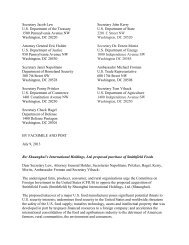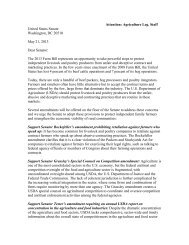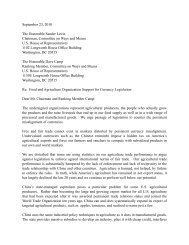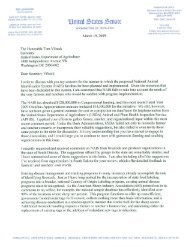Exhibit 8, 100416 Brazil FMD Risk Evaluation - R-Calf
Exhibit 8, 100416 Brazil FMD Risk Evaluation - R-Calf
Exhibit 8, 100416 Brazil FMD Risk Evaluation - R-Calf
Create successful ePaper yourself
Turn your PDF publications into a flip-book with our unique Google optimized e-Paper software.
Exposure Assessment<br />
An exposure assessment as defined by OIE describes the biological pathway(s) necessary for<br />
exposure of animals and humans in an importing country to the hazards of a given risk source, and<br />
estimates the probability of the exposure(s) occurring [20]. APHIS’ regulatory authority is limited<br />
to animal health, however, so its evaluation focuses on potential risks to animals. APHIS considers<br />
that domestic livestock are most likely to be exposed to <strong>FMD</strong>, CSF, SVD, and ASF viruses through<br />
feeding contaminated food waste to swine [21]. Other exposure pathways are more direct and<br />
include contact with imported infected live animals or contact with infected genetic material.<br />
Waste feeding to susceptible swine<br />
The likelihood of exposure of susceptible species to virus-infected meat was evaluated in previous<br />
APHIS studies. In 1995, APHIS conducted a pathway analysis to estimate the likelihood of<br />
exposing swine to infected waste. The analysis included two pathways for exposure of swine to<br />
contaminated waste: Exposure associated with illegal household imports, and exposure associated<br />
with legal imports [22]. The latter is the exposure pathway applicable to meat or meat products<br />
imported from Santa Catarina. With 95 percent confidence, APHIS estimated that 0.023 percent or<br />
less of plate and manufacturing waste would be inadequately processed prior to feeding to swine.<br />
Based on this fraction, less than 1 part in 4,300 (reciprocal of 0.023 percent) of imported meat is<br />
likely to be fed to swine as inadequately cooked waste [22].<br />
APHIS conducted a survey in 2001 of the U.S. swine waste-feeding sector to update a similar study<br />
done in 1994 [23]. Based on this survey, APHIS estimated that the proportion of plate and<br />
manufacturing waste fed to swine diminished by about 50 percent between 1994 and 2001 due to a<br />
significant decrease in the number of waste-feeding premises. The study also found that:<br />
1. Several additional States prohibited feeding food wastes to swine.<br />
2. The number of waste-feeding premises in the continental United States decreased by 40.5<br />
percent from 1994 to 2001, and in Hawaii and Puerto Rico decreased by 37.5 percent and<br />
52.3 percent, respectively.<br />
3. Institutions and restaurants provide nearly 90 percent of all plate waste fed to swine.<br />
APHIS considers that prohibiting feeding unprocessed plate waste to swine has further contributed<br />
to the reduction of swine waste-feeding. Waste-feeding operations must be licensed and inspected<br />
regularly by USDA inspectors under 9 CFR 166. The licensing process requires that producers<br />
adequately cook the waste fed to swine using methods designed to reduce the probability of survival<br />
of foreign animal disease agents.<br />
Based on the 1995 estimate that a very small proportion of food waste is inadequately processed<br />
prior to feeding to swine, and the substantial reduction in waste-feeding operations in recent years,<br />
APHIS concludes that the likelihood of exposure of susceptible swine to <strong>FMD</strong>, CSF, SVD, or ASF<br />
viruses through inadequately processed food waste is low.<br />
APHIS <strong>Evaluation</strong> of the Status of the <strong>Brazil</strong>ian State of Santa Catarina 63











